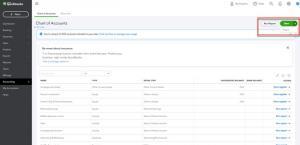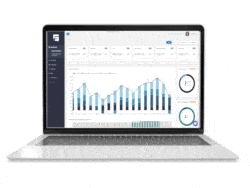Top QuickBooks Setup Mistakes (And How to Avoid Them Like a Pro)

What You'll Learn
Learn about Common Area Maintenance (CAM) management, covering its significance, expense calculations, financial stability practices, and strategies to enhance tenant satisfaction.
Common QuickBooks Setup Mistakes and How to Fix Them
QuickBooks serves as a powerful, reliable accounting tool used by hundreds of thousands of small and mid-size businesses nationwide. For commercial real estate owners, property managers, and accountants, it’s crucial for maintaining accurate records, performing calculations, and sharing data with team members. However, without proper organization, navigating QuickBooks becomes difficult and can lead to complications when integrating with property management systems like STRATAFOLIO.
By addressing common setup issues, you can ensure your QuickBooks system remains accessible, accurate, and efficient for all users. Below, we’ll explore how you can assess your QuickBooks setup for stumbling blocks and how to address them. Looking for a downloadable version of this page? Find our free guide below.
Why QuickBooks Setup Mistakes Cost You Time and Money
It’s not just minor irritation or occasional delays. When you rely on workarounds instead of building QuickBooks to support your needs, you risk major data issues, high costs, and even strained relationships. Don’t let this solvable problem harm your commercial real estate business. Read on to learn how to prevent these major concerns now.
- Wasted time: simply put, if your system isn’t clear, your team will waste time on simple tasks rather than working towards business growth. It doesn’t just cost minutes, it eliminates potential profits.
- Mistakes, miscommunications, and money: repeated entries, data overloads, and unclear organization invite errors like miscalculations or sharing incorrect reports. Plus, it’s difficult for others to catch these errors in a system that’s already confusing. Even small mistakes can add up to huge costs.
- Lost tenant trust: when you put together inefficient processes and a high probability of mistakes, the result is bad customer service. If tenants can’t rely on you for timely, accurate invoices, reconciliations, and communications, they may decide to move on from your property.
The Most Common Setup Mistakes in QuickBooks
Chart of Accounts Not Organized
In commercial real estate (CRE), base rent and additional rent are two distinct components of a tenant’s financial obligation. Base rent is the fixed amount a tenant pays to occupy the leased space, typically calculated per square foot. It covers the cost of renting the property but does not include other expenses associated with its operation. Additional rent, on the other hand, encompasses costs beyond the base rent, such as CAM fees, property taxes, and insurance. These expenses are often passed on to tenants based on their pro-rata share of the property’s total costs.
Understanding the difference between base rent and additional rent is essential for both the tenants and the owners, as it directly affects their total financial commitment and helps them plan and budget more accurately throughout the lease term. It’s important to organize your chart of accounts to clearly indicate the different categories of expense and income, such as additional rent, so that your team can see exactly how your money moves.
Frequently, we see businesses with a chart of accounts designed by a single person, for a single person. This specificity leads to issues when others need to access information, since they may have a hard time navigating. The problem is compounded when the original creator is unavailable or leaves the company. For best results, use a simple, clear chart of accounts setup that everyone can understand.
Additional tips:
Each entity and LLC should have its own QuickBooks file to prevent commingling of funds, especially if ownership structures differ between entities.
Commercial real estate should be in its own file, separate from other business activities like farms, restaurants, or retail stores.
This separation ensures transactions are clearly associated with specific parts of your portfolio, creating an easy-to-follow paper trail.

Too Many Accounts
Having too many general ledger accounts is a common issue that results in lengthy, confusing profit and loss (P&L) statements. This makes it difficult to search for specific data and increases the likelihood of human error when entering and retrieving information. When integrating with STRATAFOLIO, an excessive number of accounts may cause syncing issues. Typically, 100-300 accounts per QuickBooks file is optimal.
Another frequent mistake is creating multiple Accounts Receivable or Income accounts, such as one for each customer or tenant. QuickBooks can effectively track this information without separate accounts. Similarly, creating individual general ledger (GL) accounts for each tenant or unit creates unnecessary complexity.
Managing Accounts and Classes Effectively
Having too many general ledger accounts is a common issue that results in lengthy, confusing profit and loss (P&L) statements. This makes it difficult to search for specific data and increases the likelihood of human error when entering and retrieving information. When integrating with STRATAFOLIO, an excessive number of accounts may cause syncing issues. Typically, 100-300 accounts per QuickBooks file is optimal.
Managing Accounts and Classes Effectively
Having too many general ledger accounts is a common issue that results in lengthy, confusing profit and loss (P&L) statements. This makes it difficult to search for specific data and increases the likelihood of human error when entering and retrieving information. When integrating with STRATAFOLIO, an excessive number of accounts may cause syncing issues. Typically, 100-300 accounts per QuickBooks file is optimal.
Another frequent mistake is creating multiple Accounts Receivable or Income accounts, such as one for each customer or tenant. QuickBooks can effectively track this information without separate accounts. Similarly, creating individual general ledger (GL) accounts for each tenant or unit creates unnecessary complexity.
Managing Accounts and Classes Effectively
Having too many general ledger accounts is a common issue that results in lengthy, confusing profit and loss (P&L) statements. This makes it difficult to search for specific data and increases the likelihood of human error when entering and retrieving information. When integrating with STRATAFOLIO, an excessive number of accounts may cause syncing issues. Typically, 100-300 accounts per QuickBooks file is optimal.
Another frequent mistake is creating multiple Accounts Receivable or Income accounts, such as one for each customer or tenant. QuickBooks can effectively track this information without separate accounts. Similarly, creating individual general ledger (GL) accounts for each tenant or unit creates unnecessary complexity.
Managing Accounts and Classes Effectively
Having too many general ledger accounts is a common issue that results in lengthy, confusing profit and loss (P&L) statements. This makes it difficult to search for specific data and increases the likelihood of human error when entering and retrieving information. When integrating with STRATAFOLIO, an excessive number of accounts may cause syncing issues. Typically, 100-300 accounts per QuickBooks file is optimal.
Another frequent mistake is creating multiple Accounts Receivable or Income accounts, such as one for each customer or tenant. QuickBooks can effectively track this information without separate accounts. Similarly, creating individual general ledger (GL) accounts for each tenant or unit creates unnecessary complexity.
The solution is simple: use classes rather than additional accounts. Rather than creating numerous separate accounts or subaccounts, consider adding classes for greater specificity on your P&L statement. This approach is simpler and more flexible, allowing you to add multiple assets to a single account while maintaining detailed tracking. Classes enable you to easily view both high-level reporting and granular information as needed. Use a separate class for each building or asset when adding more than one to a single QuickBooks file. This maintains organization while avoiding unnecessary accounts.
Complex Customer Setup
Another common pitfall is in customer setup, particularly with the addition of customers and sub-customers. Using multiple levels of sub-customers creates confusion both for your team and for integrated software. In STRATAFOLIO, for example, customers are set to a single level, which means that a more complex setup in QuickBooks may prevent correct tenant invoicing.
This complexity can lead to practical problems. QuickBooks generates separate invoices for each sub-customer, potentially resulting in the same tenant being billed multiple times. It also makes it difficult to find accurate outstanding balances, complicating your accounts receivable management and potentially damaging tenant relationships.
The solution is straightforward: adjust your customer setup to avoid sub-customers. This simplified approach still allows you to find all necessary data while ensuring that integrated programs like STRATAFOLIO sync with your data. You will avoid duplicate billing, maintain tenant trust, and streamline your workflows.
Too Much Or Too Little Income Detail
Striking the right balance with income items is crucial for effective QuickBooks management. Creating too many income items, such as one for each tenant, results in an unwieldy system that’s difficult to navigate. Excessive detail complicates reporting and increases the risk of human error.
Conversely, using a single income item for all rent and rent-related payments (including common area maintenance, or CAM, charges) doesn’t provide enough detail. This makes it impossible to separate what tenants pay for specific services, preventing accurate CAM reconciliations or adjustments for upcoming years. The result is lost income and distrust between you and your tenants when you struggle to provide accurate, clear CAM reconciliations.
The solution is to find a middle ground. While you don’t need a separate income item for every tenant, you should have distinct categories for different types of income. For example, making CAM charges their own income item keeps them easily visible and distinct from rent payments. This allows accurate reconciliations without overwhelming your system.
About STRATAFOLIO
Fixing these setup issues in QuickBooks can feel overwhelming, but you’re in the right place to start. Explore more blogs and guides on QuickBooks and accounting best practices to improve your knowledge on our informational page.
STRATAFOLIO is built to tailor QuickBooks to commercial real estate needs. Offering a complete, two-way integration with both QuickBooks Desktop and Online, this software provides you with clear, customizable reports, crucial automations, and a comprehensive set of tools to handle all your accounting and management needs. To find out how STRATAFOLIO supports you through the onboarding process, including advice on QuickBooks setup, schedule a free 1:1 demo today.
Frequently Asked Questions (FAQ)
Frequently Asked Questions
-
Is STRATAFOLIO a desktop or web-based application?
STRATAFOLIO is an online web-based, secure, mobile-friendly software application service made for people who own, manage or lease real estate and use QuickBooks Online or QuickBooks Desktop as their accounting software.
-
Does STRATAFOLIO integrate with QuickBooks Online?
Yes. STRATAFOLIO has a seamless two-way integration with QuickBooks Online. When you use STRATAFOLIO to manage your commercial real estate along with QuickBooks Online, you get full automation, resulting in one easy-to-use, fully integrated property management and accounting solution. On average, customers using QuickBooks Online and STRATAFOLIO save over 80% of manual effort.
-
Do I need to have QuickBooks to use STRATAFOLIO?
Yes. STRATAFOLIO currently integrates with both QuickBooks Online and QuickBooks Desktop. If you have another integration from another accounting system you would like us to consider, please send us an email so we can add you to our waiting list of future integrations.
-
How secure is STRATAFOLIO?
At STRATAFOLIO, we make security one of our top priorities. That is one of the many reasons why we chose Microsoft Azure as our hosting provider. We gained many security benefits that come with the Azure infrastructure on our hardware and software. We have also gone above and beyond what is required in the industry to ensure your data is secure.
When you join STRATAFOLIO, you get:
- All your data is encrypted with a 256-bit Transport Layer Security (TLS) protocol.
- Your sensitive data and uploaded documents are encrypted at rest as an added layer of security.
- Two-factor authentication (2FA) is available. When 2FA is enabled, it neutralizes the risks associated with compromised passwords.
- We require a 12-character password containing at least 1 number, one non-letter or number, one lower case letter, and one upper case letter.
- We also hash all stored passwords, so even if anyone would obtain that information, those passwords would be hashed, so no one would be able to read them. When a password is hashed, it’s turned into a scrambled representation of itself, making it mathematically impossible to recover the original password.
- We implemented measures to protect against brute-force attacks by blocking someone for 30 minutes after they had six failed login attempts.
- We implemented measures to protect against Cross-Site Scripting (XSS). This prevents users from sending malicious code, generally in a browser side script to a different end-user.
- We also implemented measures to prevent against Cross-Site Request Forgery (XSRF/CSRF) attacks. These types of attacks would force an end-user to execute unwanted actions on a web application in which they’re currently authenticated.
- We have a rigorous annual security audit that entails penetration testing and security best practices along with Intuit security requirements. https://developer.intuit.com/app/developer/qbo/docs/go-live/publish-app/security-requirements
- We have a firewall strictly limiting access to the database.
- The only way a user can access STRATAFOLIO is if a STRATAFOLIO authorized user invites another user from within an existing organization. An admin can revoke login access for a user at any time.
- For your security, STRATAFOLIO doesn’t cache sensitive information.
- STRATAFOLIO uses servers and data centers that have been certified to industry standards. Certifications include ISO 27001 (data security), ISO 27017 (cloud application security controls), and ISO 27018 (protection of data in the cloud).
- Your data is continuously backed up and retained for 35 days, to guard against accidental deletion.
- STRATAFOLIO uses Geo-Replication. Meaning, if our servers in our primary region go down, we immediately switch to a backup region. As a result, you can expect no interruptions in our services.
-
Can you show the Owner Dashboard on an Accrual Basis?
No, STRATAFOLIO shows the whole platform on a cash basis only. The Owner’s Dashboard was specifically designed to show how much cash is available at any given time. For this reason, we do not show any of our reports on an accrual basis; they are only on a cash basis. To compare the QuickBooks accounts done on an accrual basis, select the Cash Basis button on the QuickBooks Reports page.
-
The depreciation and amortization expenses are showing up on the Owner’s Dashboard. What if we don’t want to see those on there?
The categories on the Owner’s Dashboard Cash Flow are not adjustable. However, if you would like to remove the amount from being displayed on the Dashboard, please let the Onboarding Team know, and we can remove them from the view.
-
Can someone help me get started?
Yes! We know you are a busy professional growing your business, and STRATAFOLIO is here to help you get started. We work with your team to gather all the necessary information, load your data, and train and complete a final audit with your team. This is part of our onboarding process.
-
Is there a charge for the onboarding?
Yes, there is a one-time onboarding fee that is based on the size of your organization and the amount of data that will be set up in your account. Contact us for more information to schedule a free demo and evaluation.
-
Is there a license fee per user?
No, in fact, we believe providing access to all your key team members (internally or externally) provides visibility to help unify and synchronize your entire team and organization.
-
I have QBD for Mac. Can I use STRATAFOLIO?
No, unfortunately, QuickBooks Desktop (QBD) for Mac does not support Web Connector. This makes it incompatible with STRATAFOLIO because we use Web Connector to synchronize the data between QBD and STRATAFOLIO.
-
Do I need to have QuickBooks to use STRATAFOLIO?
Yes. STRATAFOLIO currently integrates with both QuickBooks Online and QuickBooks Desktop. If you have another integration from another accounting system you would like us to consider, please send us an email so we can add you to our waiting list of future integrations.
-
You asked for our previous CAM reconciliations: why?
We set up your CAM Reconciliation Reports to match what you have already given to your tenants. If you would like, during the Onboarding process, we will review the report and suggest ways to make it more complete or easier for the tenant to understand.
-
The depreciation and amortization expenses are showing up on the Owner’s Dashboard. What if we don’t want to see those on there?
The categories on the Owner’s Dashboard Cash Flow are not adjustable. However, if you would like to remove the amount from being displayed on the Dashboard, please let the Onboarding Team know, and we can remove them from the view.
Download Top QuickBooks Setup Mistakes Guide

Want to talk to an expert?
Learn how you can keep using QuickBooks and save over 80% of manual effort when using STRATAFOLIO to manage your operations, global finances, assets, and investors. Utilize our two-way connection with QuickBooks to gain one fully integrated system.
